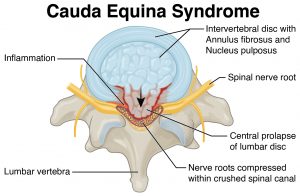
There’s a collection of nerve roots at the bottom of your spinal cord that affects your legs and bladder. When an injury or herniated disk or other problem compresses those nerves, then that causes pain, weakness, and incontinence. Cauda equina syndrome is a medical emergency.
What is cauda equina syndrome?
Cauda equina syndrome is the compression of a collection of nerve roots called the cauda equina. Nerves send and receive electrical signals all across your body. The collection of nerve roots, shaped like a horse’s tail, is located at the bottom of your spinal cord.
Because of the cauda equina nerves, you can move and feel sensations in your legs and urinary bladder. Compressed cauda equina nerves can cause pain, weakness, incontinence, and other symptoms. This syndrome can cause permanent damage, including paralysis if left untreated. Quick treatment might prevent permanent damage like paralysis.
There are two types and two classifications of cauda equina syndrome. The syndrome is acute or chronic, and it’s either complete or incomplete.
Types of cauda equina syndrome
Acute cauda equina syndrome
Severe symptoms start suddenly. You’ll likely need surgery within 24 to 48 hours.
Chronic cauda equina syndrome
This name means long-lasting cauda equina syndrome. It describes two scenarios:
- If you’ve had symptoms of cauda equina syndrome for some time before you see a healthcare provider, it’s labeled chronic.
- If the surgery doesn’t fix your nerves and there is permanent damage, you’ll likely have symptoms for the remainder of your life. Your healthcare provider calls these symptoms chronic.
Emergency surgery might stop permanent damage.
What are the symptoms of cauda equina syndrome?
There are several red flags that you might have cauda equina syndrome:
- Numbness or different sensations in the backs of your legs, butt, hip, and inner thighs (your saddle area, as in the parts of your body that would touch the saddle if you were on a saddled horse).
- Pain in your back and legs (sciatica).
- Problems having sex.
- Urinary and/or fecal incontinence.
- Urinary retention.
- Weakness or paralysis in your lower extremities.
You might experience more symptoms in addition to the red flags. They include:
- Lower back pain.
- Burning, prickling, tingling, or numbness in the lower limbs (paresthesia).
- Reflexes issues.
How can I prevent cauda equina syndrome?
It may not be possible to prevent all of the causes of cauda equina syndrome. But, you might be able to reduce your risk of a herniated disk, the most common cause of the syndrome. Try the following tips:
- Avoid wearing high-heeled shoes. These types of shoes can misalign your spine.
- Stop smoking. Avoid using other tobacco products as well because they can weaken your disks.
- Exercise. Try exercises that strengthen your back and abdominal muscles.
- Lift properly. Bend your knees and keep your back straight when you lift something instead of bending at your waist.
- Maintain a healthy weight. Extra weight adds extra pressure to your lower back.
- Practice good posture. That will reduce strain on your spine.
- Stretch. Stretch your body periodically, especially after sitting for a long time.
0 Comments